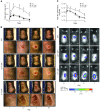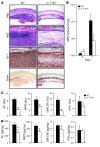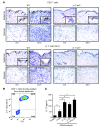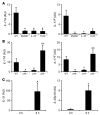IL-17 is essential for host defense against cutaneous Staphylococcus aureus infection in mice
- PMID: 20364087
- PMCID: PMC2860944
- DOI: 10.1172/JCI40891
IL-17 is essential for host defense against cutaneous Staphylococcus aureus infection in mice
Erratum in
-
Corrigendum to IL-17 is essential for host defense against cutaneous Staphylococcus aureus infection in mice.J Clin Invest. 2025 Sep 2;135(17):e198106. doi: 10.1172/JCI198106. eCollection 2025 Sep 2. J Clin Invest. 2025. PMID: 40892507 Free PMC article. No abstract available.
Abstract
Staphylococcus aureus is the most common cause of skin and soft tissue infections, and rapidly emerging antibiotic-resistant strains are creating a serious public health concern. If immune-based therapies are to be an alternative to antibiotics, greater understanding is needed of the protective immune response against S. aureus infection in the skin. Although neutrophil recruitment is required for immunity against S. aureus, a role for T cells has been suggested. Here, we used a mouse model of S. aureus cutaneous infection to investigate the contribution of T cells to host defense. We found that mice deficient in gammadelta but not alphabeta T cells had substantially larger skin lesions with higher bacterial counts and impaired neutrophil recruitment compared with WT mice. This neutrophil recruitment was dependent upon epidermal Vgamma5+ gammadelta T cell production of IL-17, but not IL-21 and IL-22. Furthermore, IL-17 induction required IL-1, TLR2, and IL-23 and was critical for host defense, since IL-17R-deficient mice had a phenotype similar to that of gammadelta T cell-deficient mice. Importantly, gammadelta T cell-deficient mice inoculated with S. aureus and treated with a single dose of recombinant IL-17 had lesion sizes and bacterial counts resembling those of WT mice, demonstrating that IL-17 could restore the impaired immunity in these mice. Our study defines what we believe to be a novel role for IL-17-producing epidermal gammadelta T cells in innate immunity against S. aureus cutaneous infection.
Figures








References
Publication types
MeSH terms
Substances
Grants and funding
LinkOut - more resources
Full Text Sources
Other Literature Sources
Molecular Biology Databases

